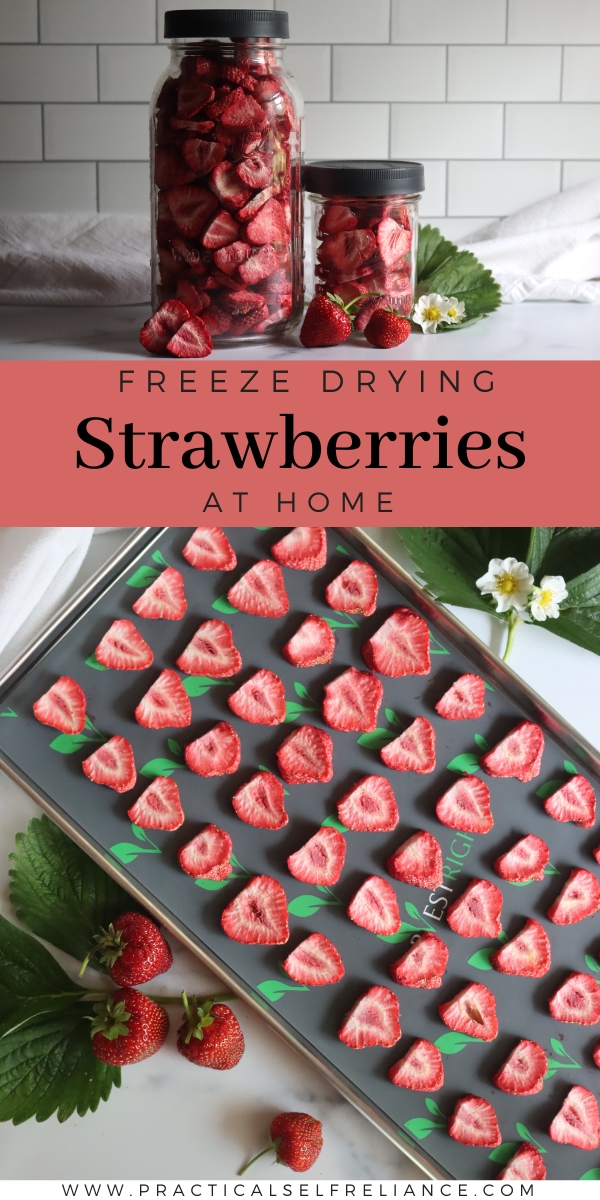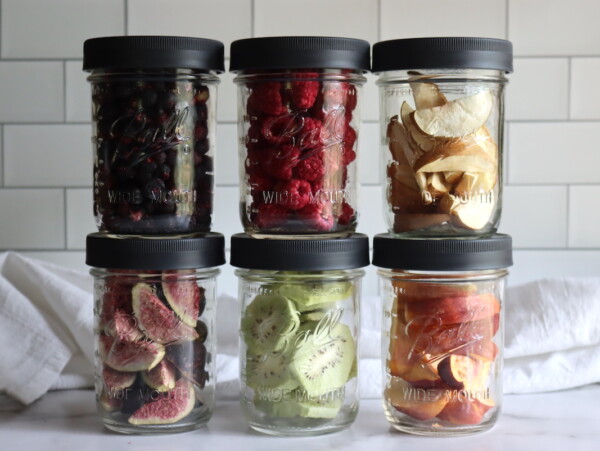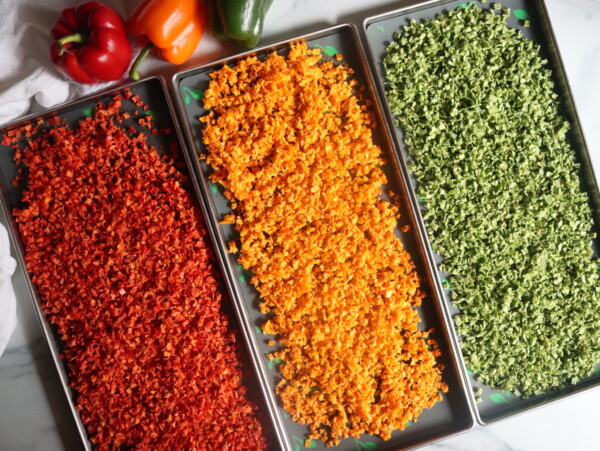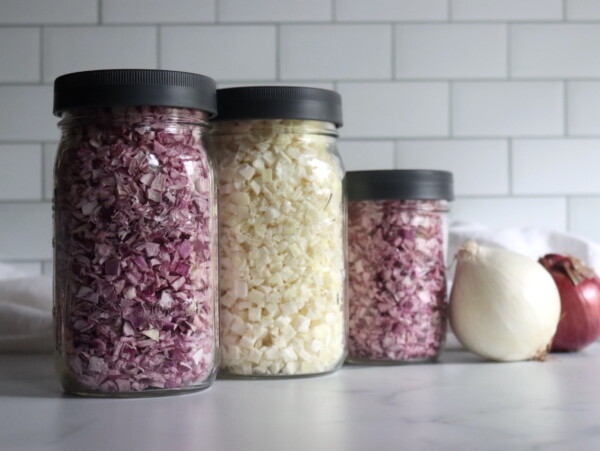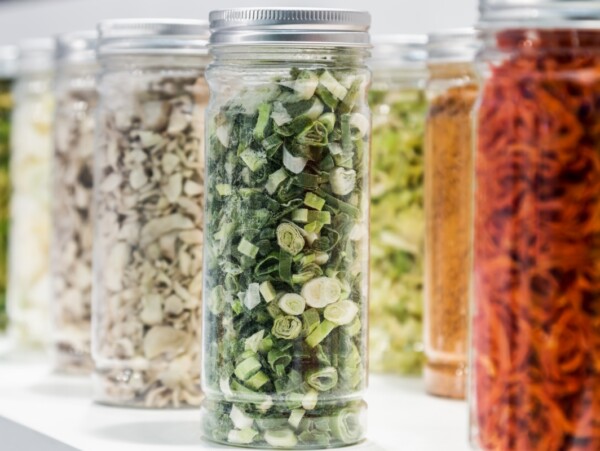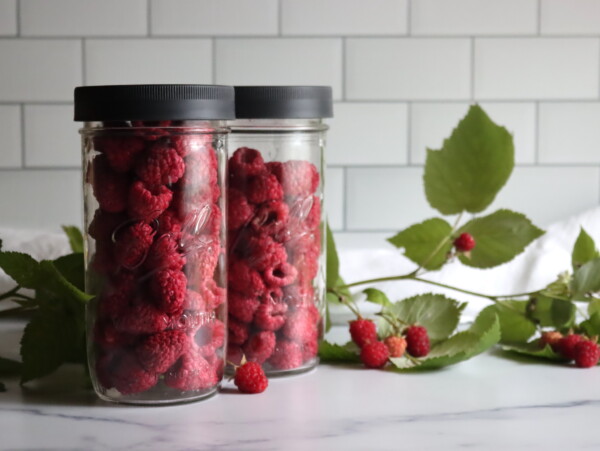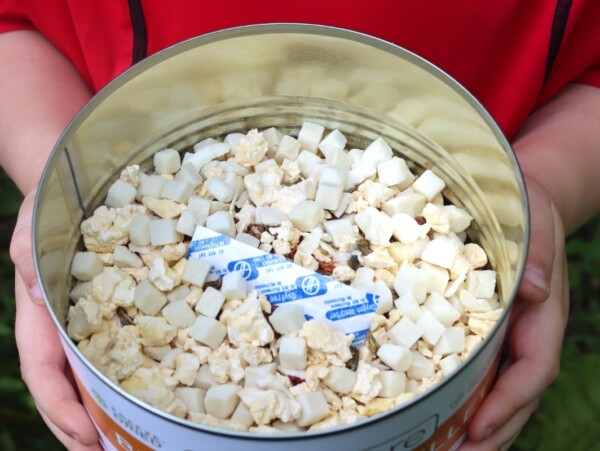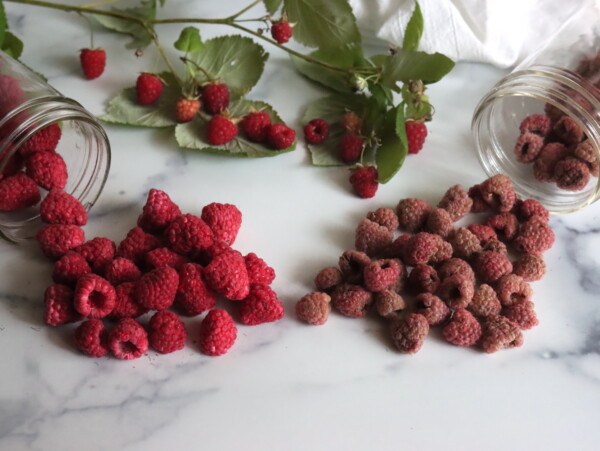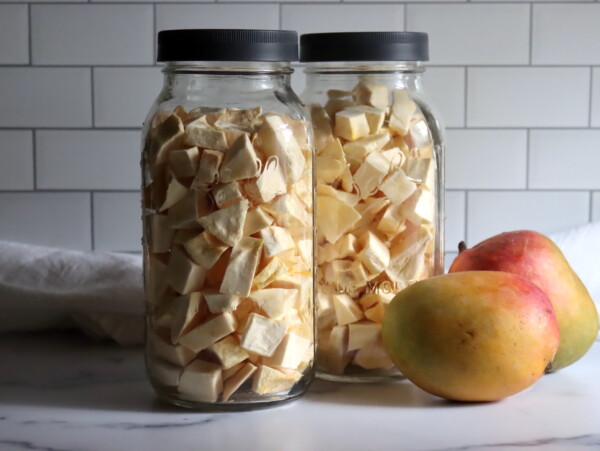Affiliate disclosure: This post may contain affiliate links. Please see our Privacy Policy.
Freeze-dried strawberries are one of the best freeze-dried foods out there. While they can be expensive to buy, freeze-drying strawberries at home is simple!
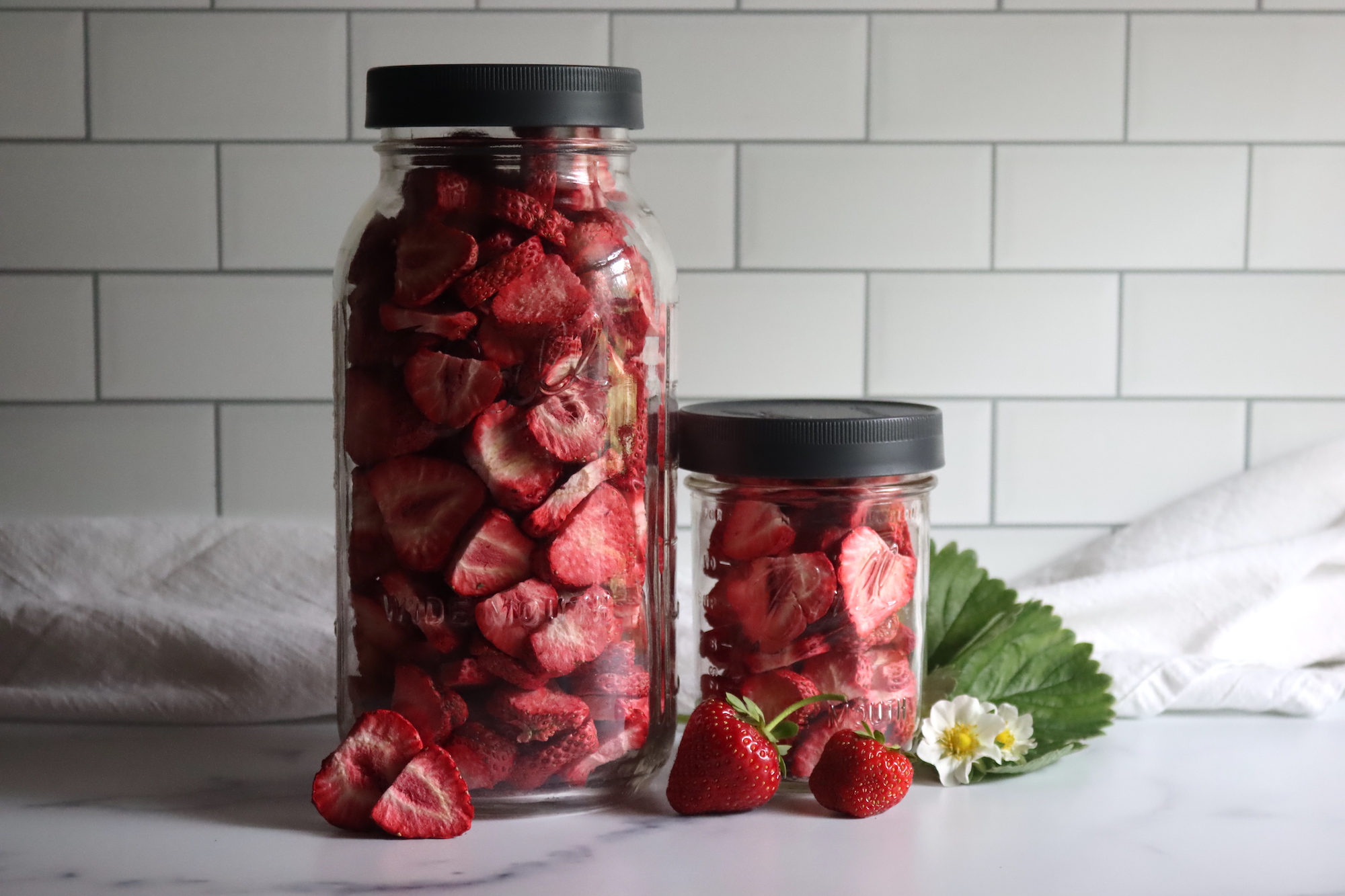
Table of Contents
- What’s the Difference Between Freeze Dried Strawberries and Dehydrated Strawberries?
- Best Strawberries to Freeze Dry
- Freeze Dried Strawberry Yield
- Supplies Needed
- Preparing Strawberries for Freeze-Drying
- How to Freeze Dry Strawberries
- Reconstituting Freeze Dried Strawberries
- How to Store Freeze Dried Strawberries
- Freeze Drying Strawberries Recipe
- Freeze Drying Guides
My kids never get tired of freeze-dried strawberries, and for a while, we were buying them by the no. 10 can full for healthy snacks on the go. Given free rein, they go through several cans a week!
They’re low calorie, full of nutrients and they give you the satisfying crunch of a snack food (without all the unhealthy ingredients from crunchy foods like chips).
Freeze-drying strawberries concentrates all their wonderful flavor, so they’re intensely delicious (and arguably tastier than fresh strawberries, depending on who you ask).
When we got our home freeze dryer, our homegrown strawberries were one of the first things I freeze-dried at home. It’s quick and easy, and now I know that my kids are enjoying nutrient-dense, unsprayed fruit, and I can pack it up for year-round use.
Our growing season here in Vermont is short, but now that I’m freeze-drying fruit at home, we can enjoy it year-round (without all the added sugar in jams and preserves).
If you’re not familiar with home freeze drying, I’d suggest you start by reading my beginner’s guide to freeze drying at home. And, of course, you will need a home freeze dryer to get the job one, and I reccomend harvest right freeze dryers.
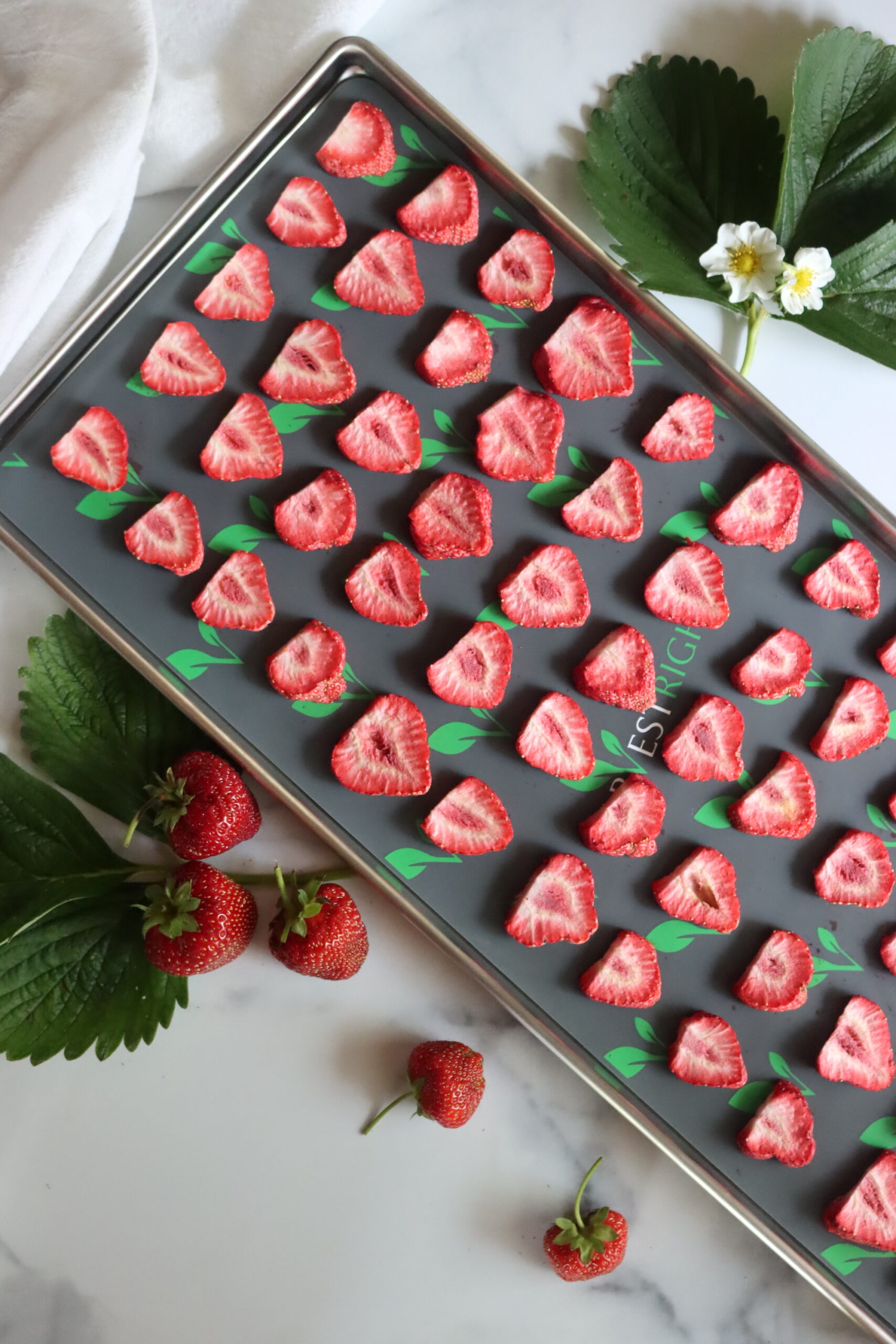
What’s the Difference Between Freeze Dried Strawberries and Dehydrated Strawberries?
Freeze-dried strawberries are dramatically different than dehydrated strawberries, in terms of flavor, texture, and shelf life.
Dehydrating uses heat, which gives the fruit a cooked flavor, driving off some of the aroma and fresh taste. The fruit shrinks, and becomes a bit rubbery and hard to chew. Dehydrated fruit just won’t rehydrate back to the same thing, and once you’ve dehydrated something, it’s shrunk and rubbery forever.
Don’t get me wrong, dehydrated strawberries are still good, but they’re nothing like freeze-dried.
The freeze drying process basically stops time, and preserves the shape, texture, flavor, and aroma of fresh strawberries. They’re cooled (rather than heated) so they don’t taste cooked.
And, of course, the shelf life of freeze dried food is much longer than dehydrated.
We love them as crunchy snacks as is, but with freeze-dried, you can add water and rehydrate the fruit back to basically the same size, texture, flavor, and appearance as before it went into the machine. (That’s perfect for cereal, topping ice cream, or homemade pies.)
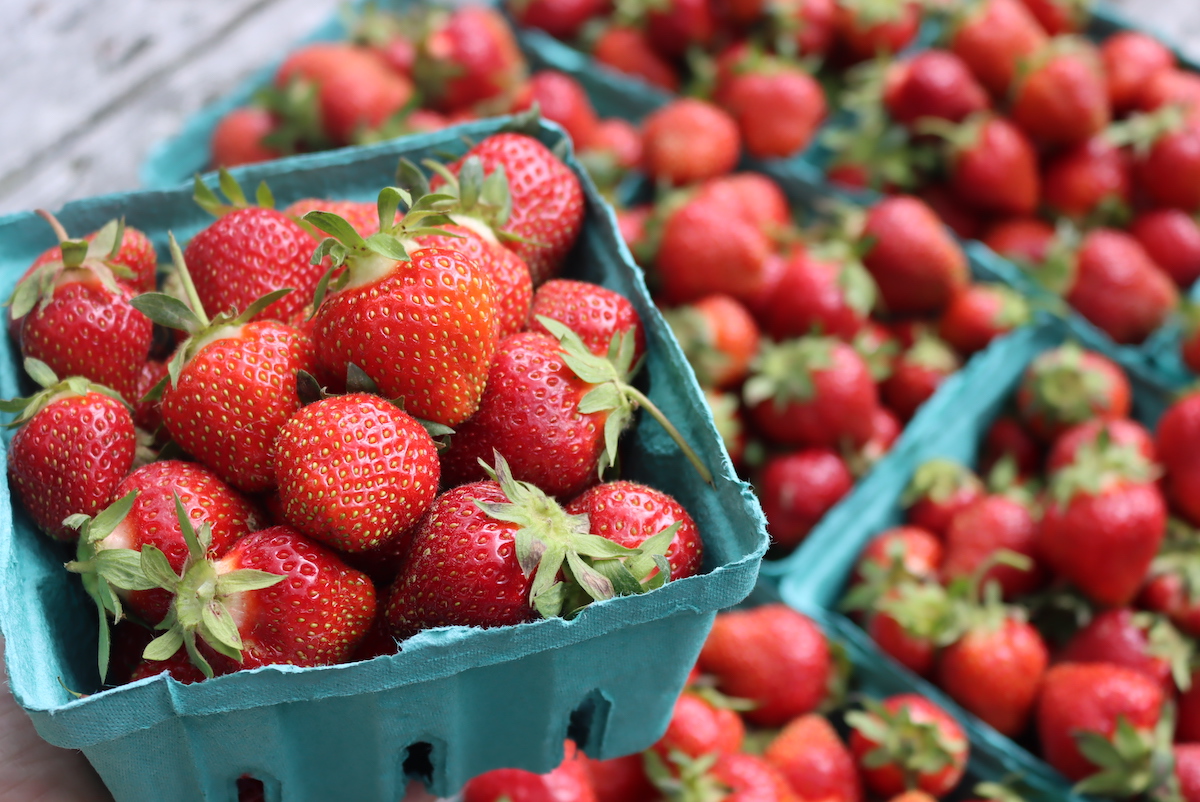
Best Strawberries to Freeze Dry
The quality and fresh flavor of your fresh strawberries will determine the quality of your homemade freeze-dried strawberries. If you have flavorless, sour, or underripe fruit to start with, freeze-drying isn’t going to improve it.
Starting with sweet, aromatic, fresh strawberries is the way to go. We grow heirlooms here on our homestead (Sparkle and Mara des Bois are our favorites), but if you’re purchasing strawberries, try to work with a local farmer who prioritizes flavor (rather than shelf life for shipping).
Always try your strawberries before they go into the machine, and if they taste great, they’ll make wonderful freeze-dried strawberries.
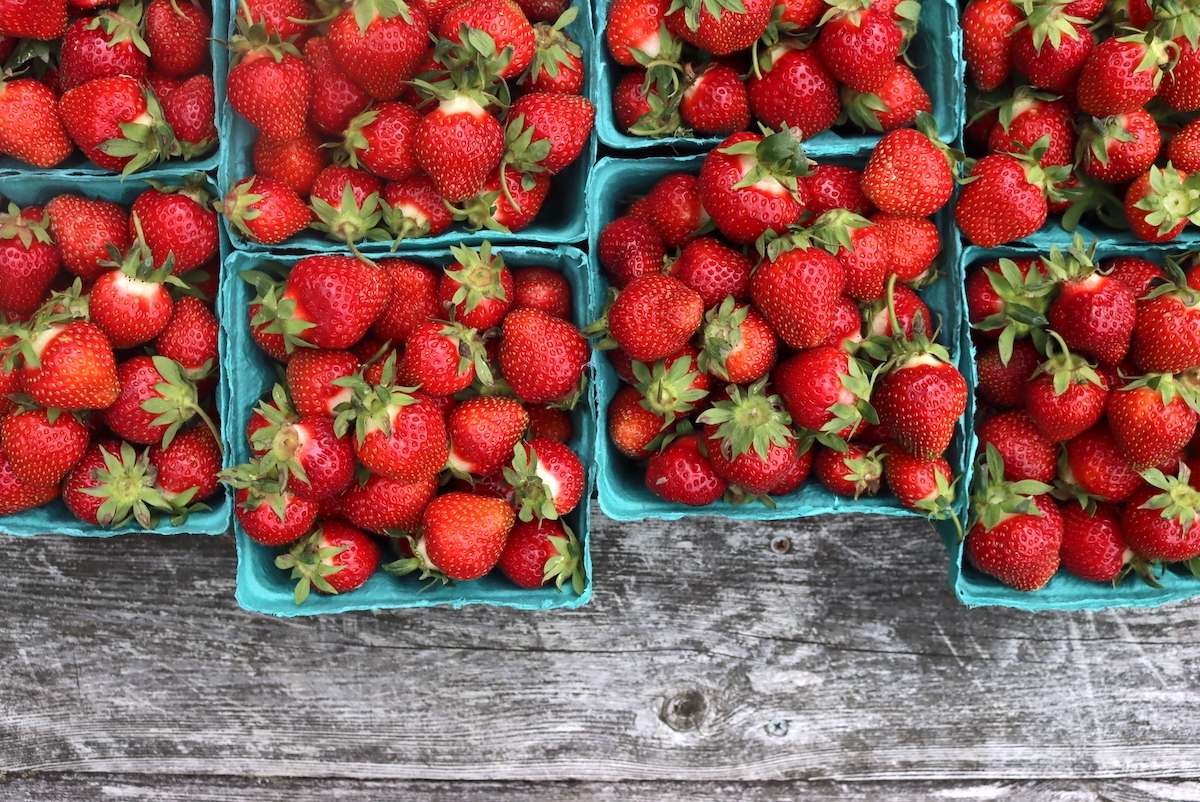
Freeze Dried Strawberry Yield
A pound of fresh strawberries is about 3 to 3 ½ cups of fresh fruit. Strawberries stay the same size when freeze-dried, so a cup of fresh strawberries will yield a cup of freeze-dried strawberries.
One cup of whole berries will yield about 3-4 Tbsp (a scant ¼ cup) of freeze-dried strawberry powder if you grind it up in a food processor, and that’s nice for flavoring baked goods and frosting (or for smoothies).
How many you make in a batch depends on the size of your machine and how tightly you pack the trays. Ideally, the fruit would be in a single layer to ensure even drying, but you can get away with some overlap, provided you don’t fill the trays higher than the rims.
I have a large freeze dryer, but it’s an older model, and the large dryers they’re selling these days are bigger and have 6 trays. Mine is rated for drying 15 to 20 pounds of food per batch, across 5 drying trays. That means you’re drying about 3 to 4 pounds of strawberries per tray, if you really pack the trays tightly.
(I’ve found that 2-3 pounds per tray works better. There is less fruit per batch, but drying times are shorter, and the fruit dries more evenly and looks nicer when it comes out of the machine.)
Each freeze drying machine is rated for a different amount of fresh food, and here are the average yields based on machine size:
- Small Freeze Dryer: Processes 6 to 10 pounds of food per batch, across 4 trays (434 square inches of drying space).
- Medium Freeze Dryer: Processes 10 to 15 pounds of food per batch, across 5 trays (675 square inches of drying space).
- Large Freeze Dryer: Processes 18 to 27 pounds of food per batch, across 6 trays (1107 square inches of drying space).
- Extra Large Freeze Dryer: Processes 40 to 50 pounds of food per batch, across 7 trays (2257 square inches of drying space).
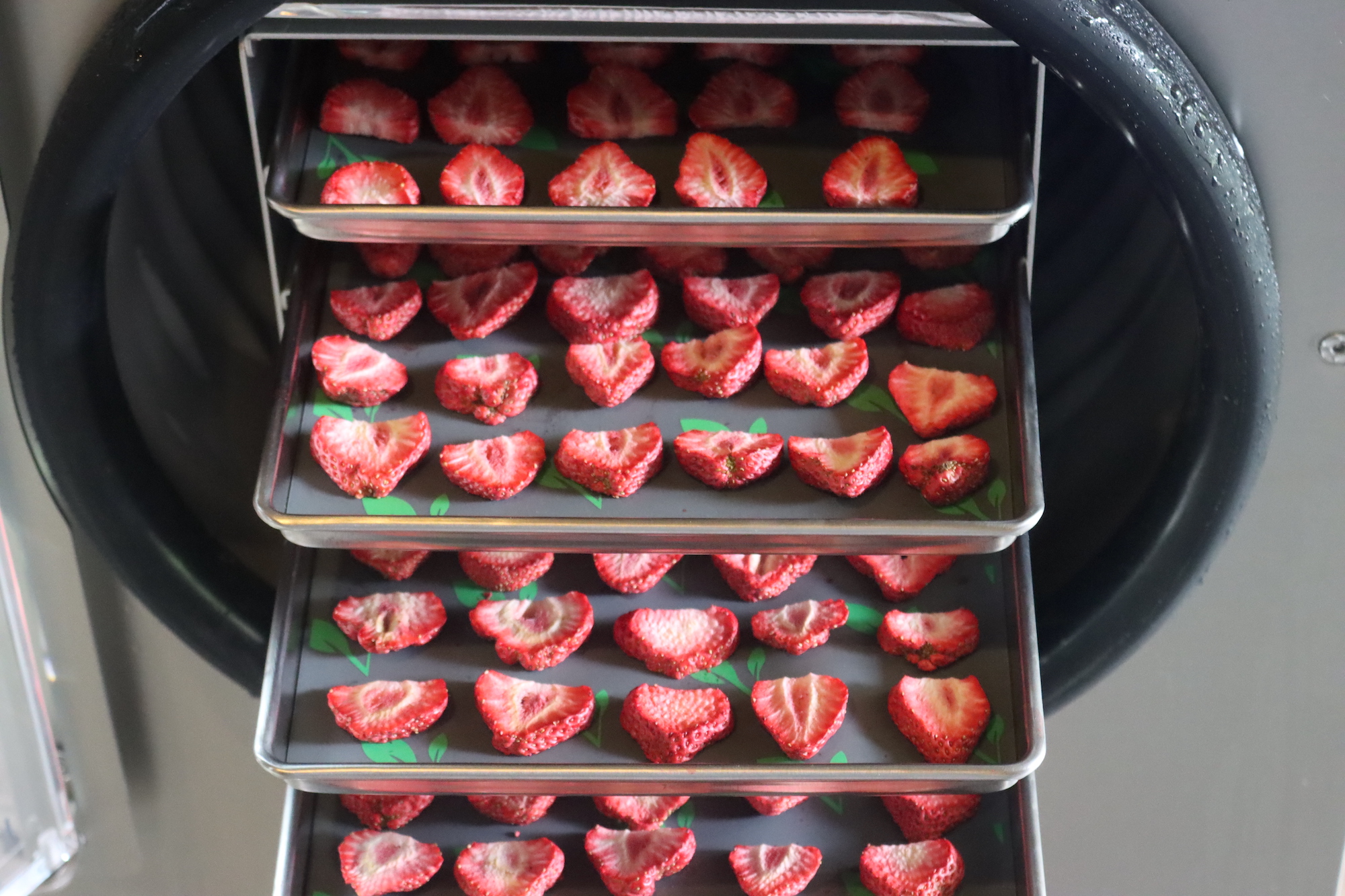
Supplies Needed
To freeze dry strawberries at home, you’ll need the following:
- Strawberries, fresh or frozen (pre-frozen fruit works just fine)
- Home Freeze Dryer – Larger models are more efficient and cost less to run per pound of finished fruit, so opt for the biggest model you think you’ll be able to use for your family.
- Cutting Board and Knife – For chopping strawberries into uniform ¼ inch slices. You can also halve them, dice them, or leave them whole. Even slices dry the best.
- Silicone Tray Liners (or Parchment Paper) – The berries will stick to trays, and cleanup is much easier if you line the trays before freeze drying. (The finished berries will look better too, since you won’t be prying them off the trays.)
- Colander and Towels – You’ll want to wash the fruit before freeze-drying, but make sure you dry it completely on towels before putting it on the trays. Extra water will extend the freeze-drying time.
- Mason Jars (Or Airtight Storage Containers) – We store our freeze-dried fruit in mason jars because it will be used within a year, and there’s no need to pack it in Mylar for long-term storage. If you are planning on storing it for an extended period, packing it in Mylar bags with oxygen absorbers is essential.
- Vacuum Sealer (Optional) – A vacuum sealer will allow you to seal your food in mason jars with minimal air, ensuring a longer shelf life.
- Label Tape and a Pen – Labeling and dating your preserved food is essential, especially if you’re putting it up in mylar bags where you can’t see the contents. Even in a jar, dates are important!
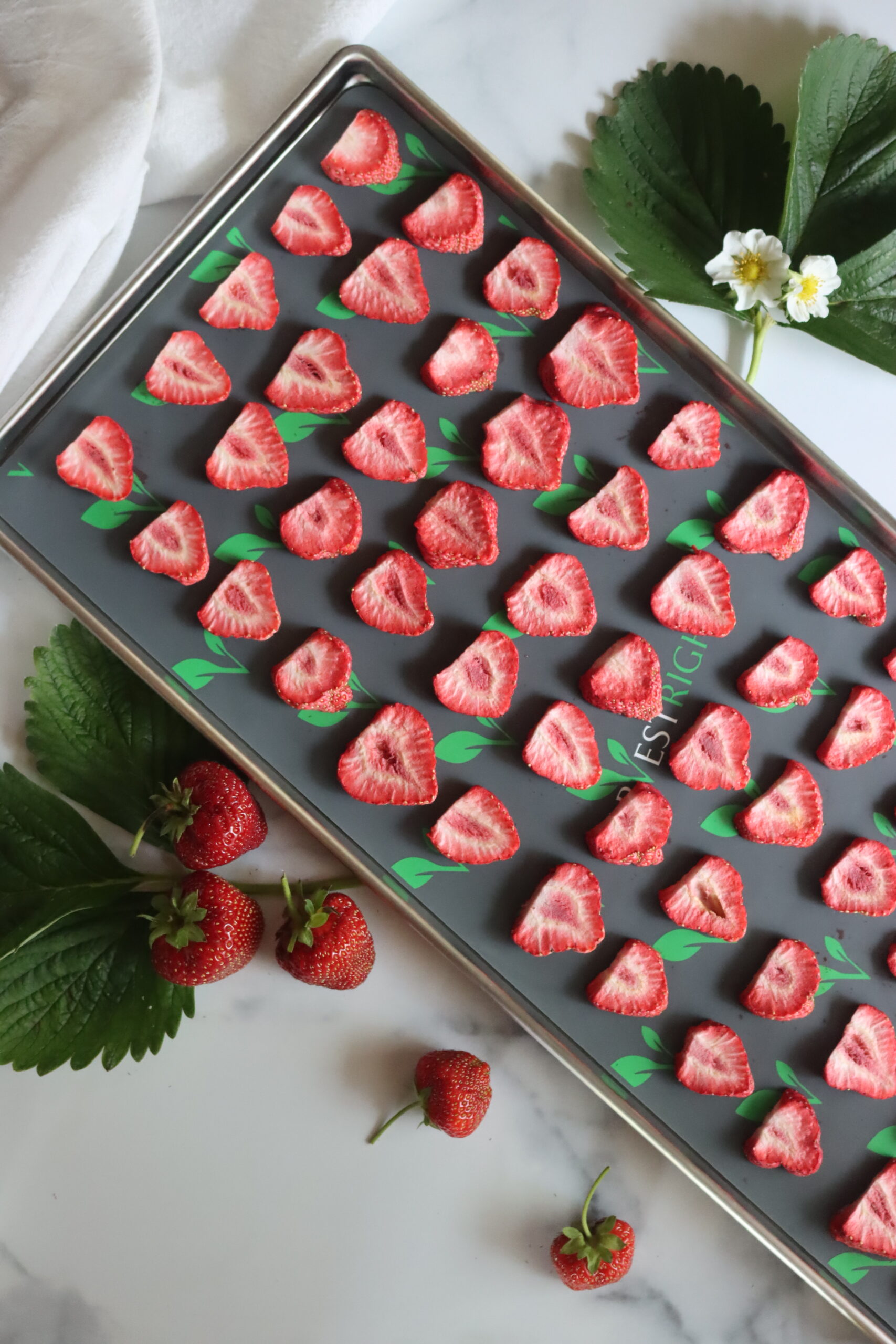
Preparing Strawberries for Freeze-Drying
You can prepare your strawberries for freeze-drying in any way you like. Small fruit can be left whole, but I recommend removing the tops for ease of use later.
Slicing the strawberries into even ¼ inch slices yields the best results, the fastest dry time, and quite frankly, the prettiest fruit in a jar (or for use in your home cooking). We eat with our eyes as well, and attractive food just tastes better (even if it is all in our heads).
It’s also perfectly fine to dice the fruit, and on occasion, I’ve used our Breville Slice and Dice food processor, which will neatly cube the fruit into even 8mm, 12mm, or 16mm pieces in seconds. (That’s ⅓ inch, ½ inch, and ⅔ inch cubes.) It’s incredibly handy when preserving food of all kinds, and I use it all the time when canning and freeze-drying.
If you’re planning on making strawberry powder in the end, you can also freeze dry trays of strawberry puree. You’ll get more fruit into the freeze dryer in one batch that way, but it’s faster (but messier) to prep. The downside is it’s less versatile since slices can be turned into powder easily…but once it’s a powder, it’s not going back to slices!
If I have extra space in a batch, I also freeze-dry my strawberry tops, and they’re wonderful in homemade tea (hot or iced). Strawberry leaves are edible, and traditionally used in tea. You get a tiny bit of strawberry flavor from the bit of fruit left too, so it’s delicious (and a better use than just composting them).
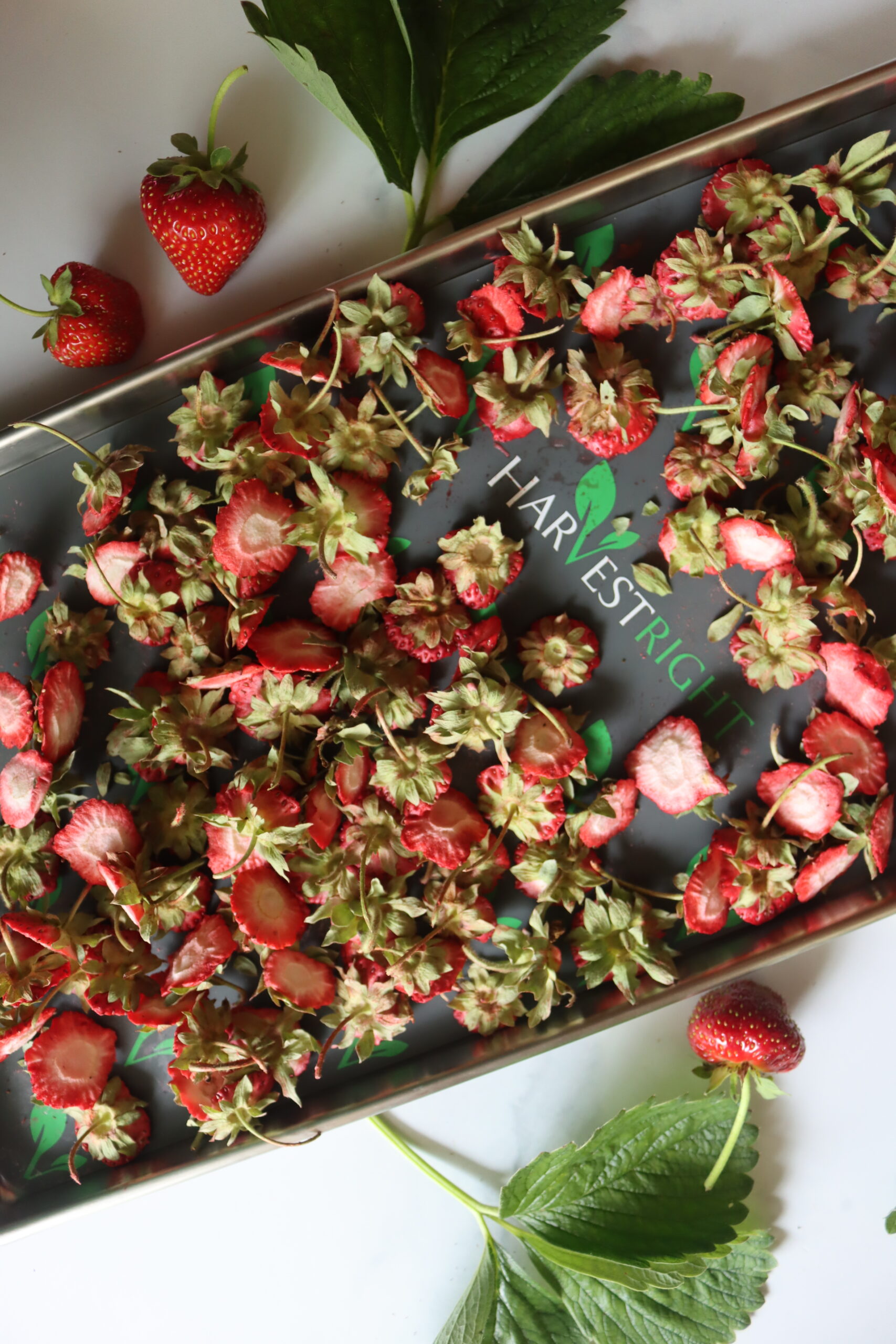
How to Freeze Dry Strawberries
Once you’ve prepared your strawberries, the freeze-drying process is simple.
Turn on your freeze dryer and allow it to pre-chill for at least 30 minutes before adding in the trays of fruit.
Line your freeze dryer trays with silicone liners (or parchment paper) and arrange the prepared fruit on the trays. Whole, sliced, diced or pureed, whatever you’ve chosen.
For a faster process time, you can pre-freeze the fruit (either in bags, or directly on the trays). This cuts down the total freezing time in the machine, and your batch will finish faster than if you’d added room temperature fruit.
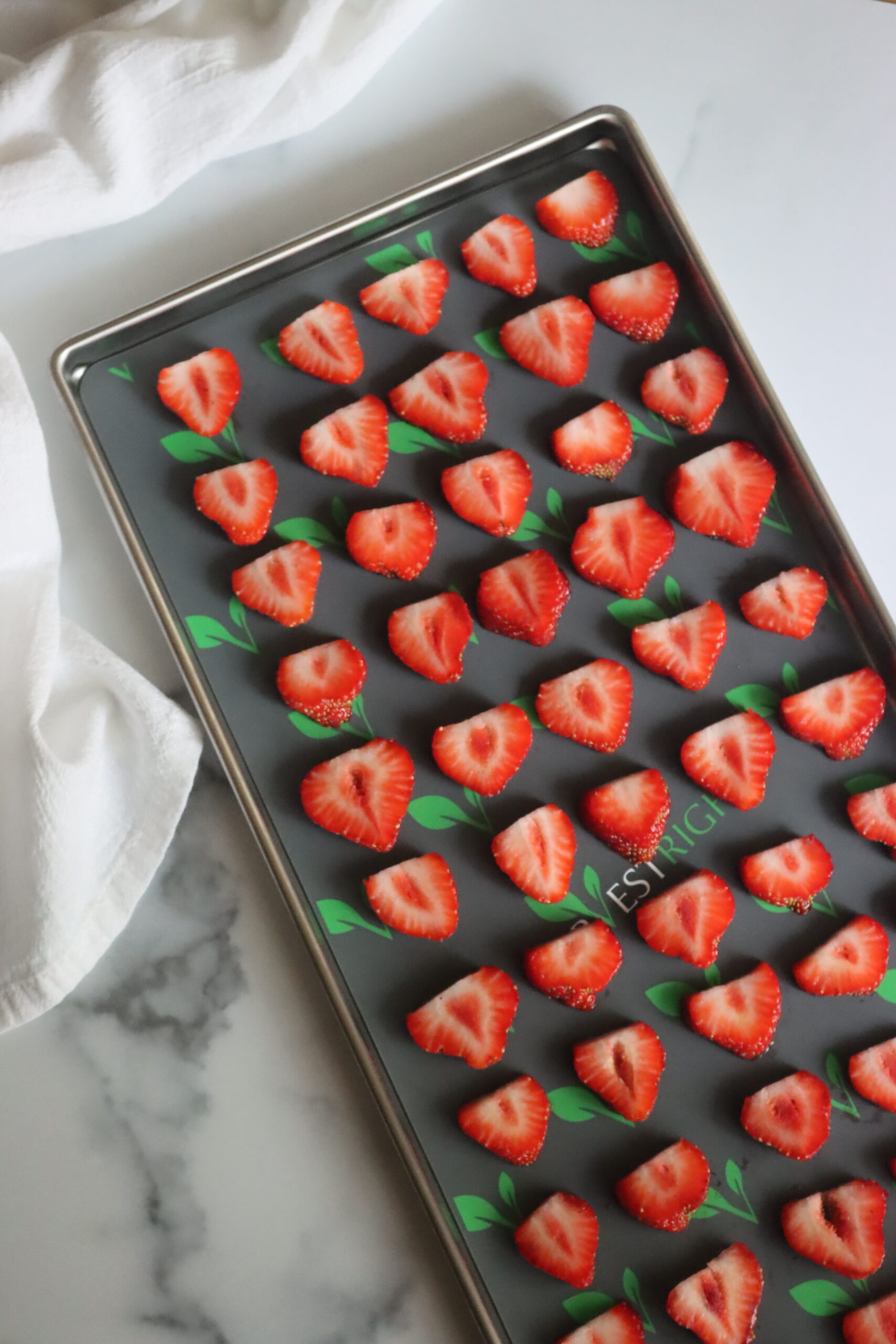
We have a big chest freezer out next to our freeze dryer, and we leave a section of it empty so we can stack trays of fruit to pre-freeze before putting them into the machine. You can get convenient tray lids that really help keep things neat, and allow you to stack the trays in your freezer.
If you just have a small home freezer (not a big deep freeze), then freezing the fruit on the trays isn’t practical (since the trays won’t fit in a small freezer). You’ll just need to put it into the freeze dryer as is, or pre-freeze the fruit in freezer bags. That can be messy though, and your fruit will stick together in the bag. It really does work best pre-frozen on trays, or not at all.
Once the freeze dryer is pre-chilled, put the trays in the freeze dryer and press “continue.”
At this point, the machine does the rest!
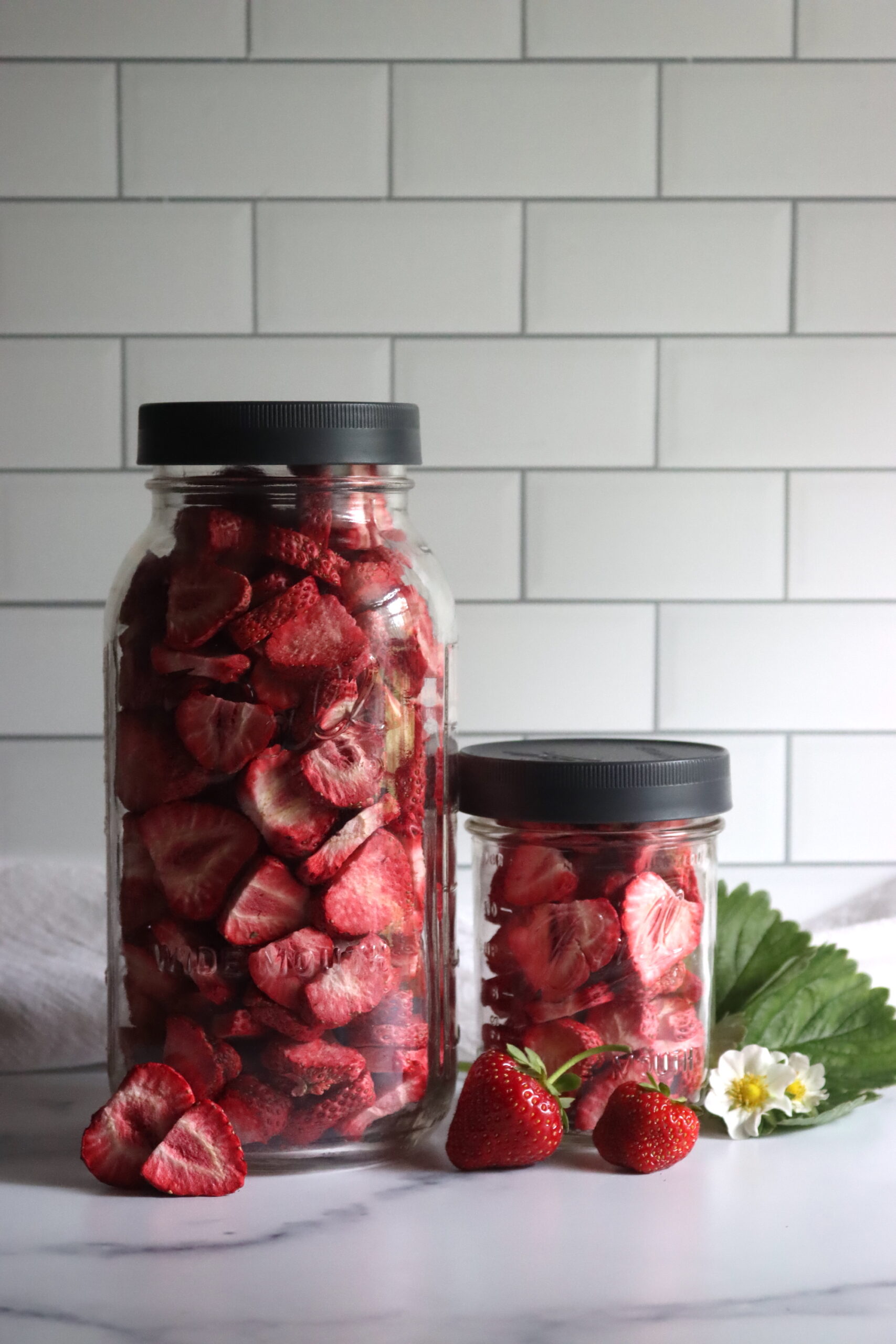
Usually, it takes about 20 to 24 hours to freeze dry strawberries, but the total time will depend on your particular situation. The main factors are:
Pre-Freezing: If your fruit goes into the freeze dryer already pre-chilled or frozen, that cuts down on the initial freezing time
Piece Size: Larger pieces take longer to freeze dry
Moisture in the Fruit: Commercial fruit tends to be firmer and lower moisture than backyard-grown heirloom fruit
When the strawberries are fully freeze-dried, they should be firm, completely dry and snap easily between your fingers.
Test the batch by choosing one of the largest or thickest pieces and snapping it in half. Check the inside for moisture, and make sure it’s firm and fully dried.
If they’re not fully dried, you can extend the time on your drying cycle by a few more hours.
The final flavor of your freeze-dried strawberries will depend on how good the strawberries were when they were prepared. Freeze drying doesn’t change the flavor of foods, so if the strawberries were sweet and aromatic when they went into the freeze dryer, that’s how they’ll taste when they come out.
If anything, freeze drying concentrates the flavor and enhances it, as it’s not diluted with water. Choose the freshest, most flavorful strawberries you can find for the best results.
If properly packed, freeze dried strawberries can last 30+ years. That means storing in well sealed mylar pouches with oxygen absorbers.
When just casually stored on the pantry shelf in a mason jar, they’ll maintain quality for 1-2 years if sealed. If the jar is frequently opened, they’ll absorb water from ambient humidity and may spoil sooner.
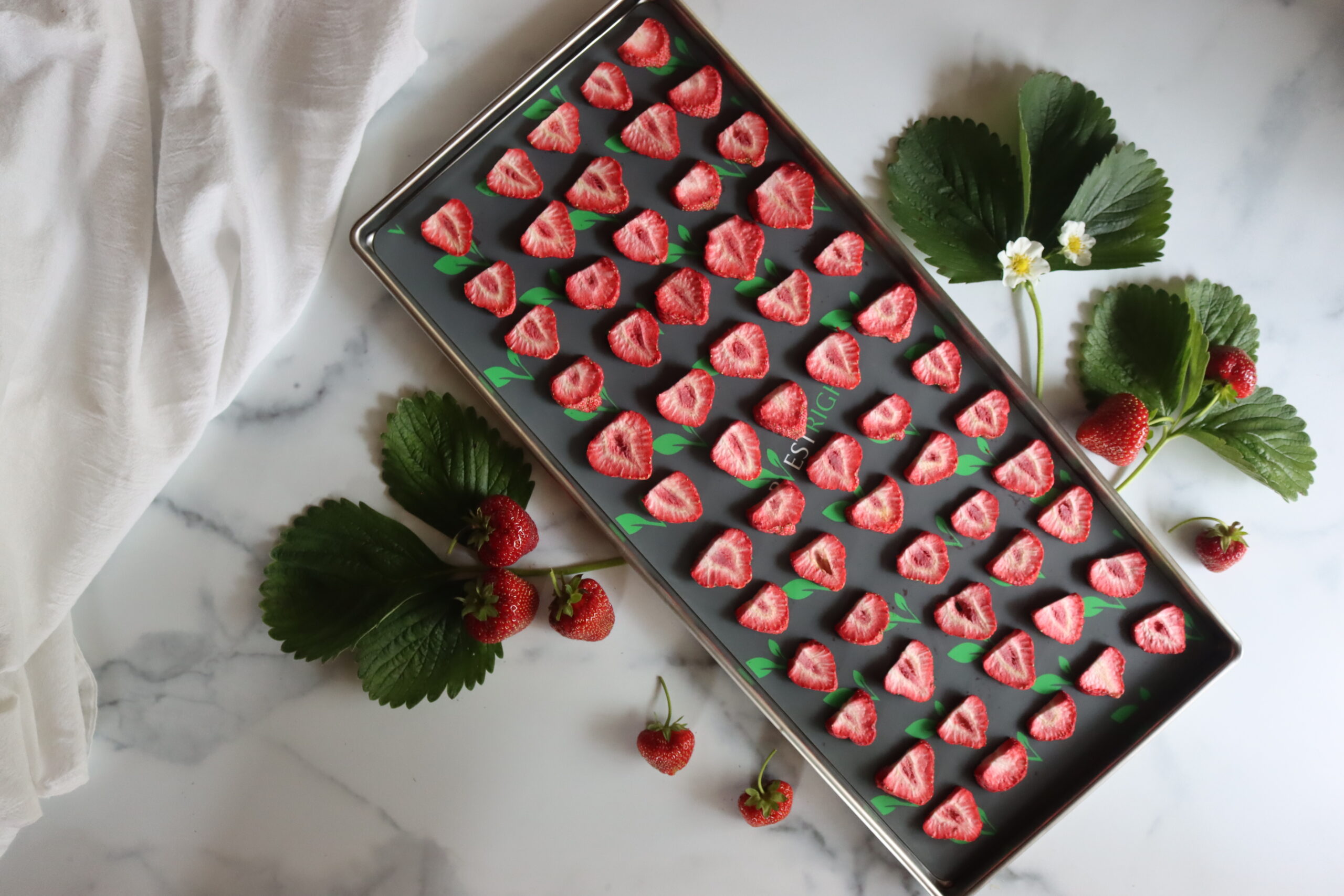
Reconstituting Freeze Dried Strawberries
For the most part, people use freeze-dried strawberries just as they are. You can eat them as a snack, or toss them right into a bowl of cereal or granola.
If you want to use them in a pie, muffins or some other baked good, it’s best to rehydrate them fully before incorporating them into your recipe.
To rehydrate freeze dried strawberries, cover the fruit completely with warm water and allow the fruit to soak for about 20 to 30 minutes. Drain any excess water, and then proceed with your recipe.
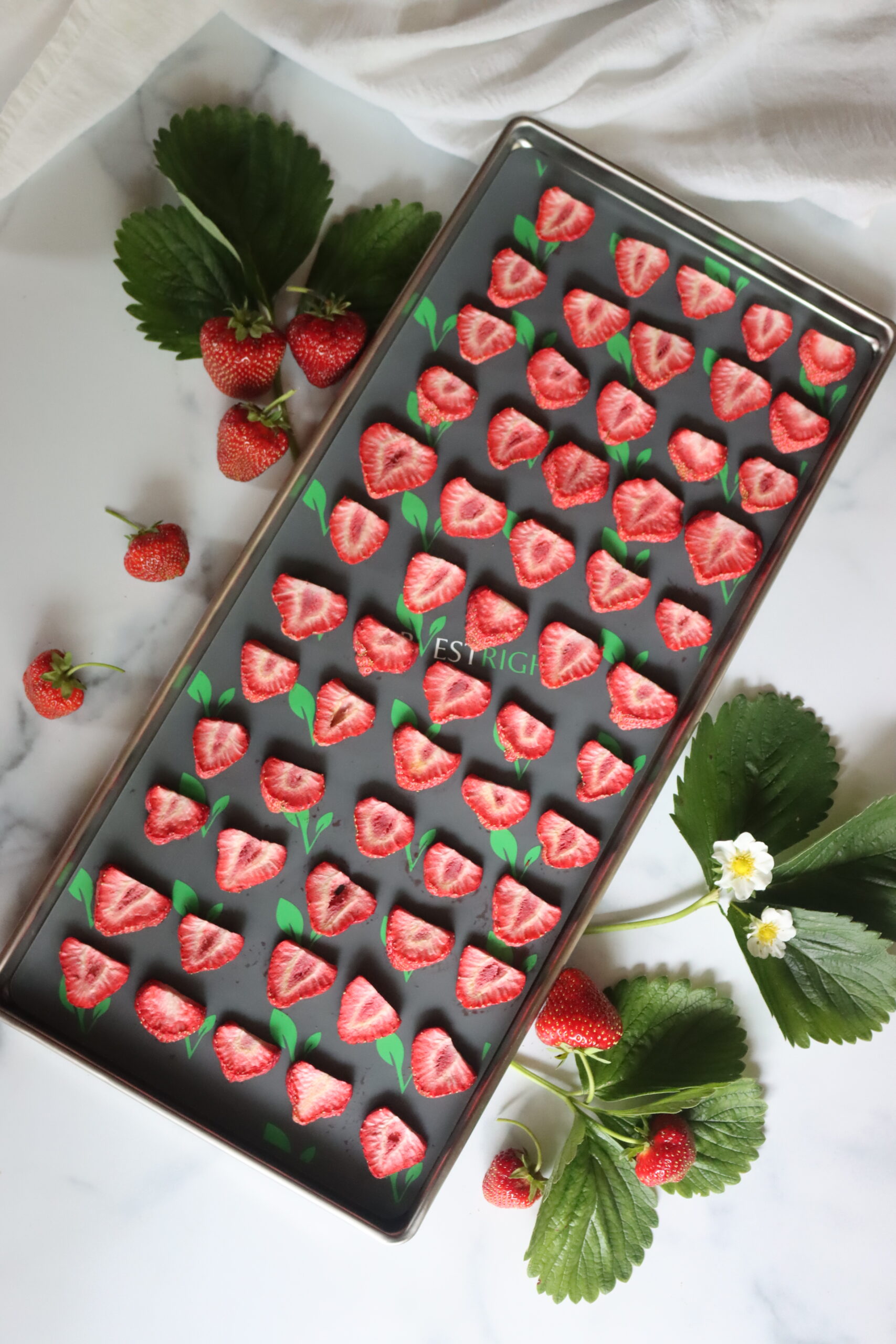
How to Store Freeze Dried Strawberries
For short term storage and snacks, your freeze dried strawberries can simply be stored in a mason jar (or other similar container) with a tight fitting airtight lid. This works wonderfully on you pantry shelf if you have little ones around that aren’t going to let those beauties last too long before they become snacks.
For long-term storage, freeze-dried foods need to be packed into mylar pouches with oxygen absorbers.
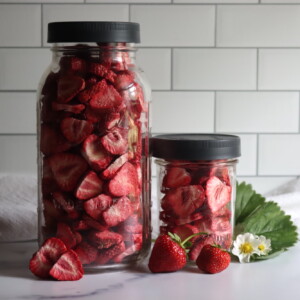
Freeze Drying Strawberries
Ingredients
- Fresh or Frozen Strawberries
Instructions
- Start by pre-chilling your freeze dryer for at least 30 minutes.
- Slice your strawberries into uniform pieces, ideally about ¼ inch thick to encourage fast and even drying. (Slicing is optional, and you can freeze dry whole strawberries, it’ll just take longer. Diced chunks or strawberry puree also works.)
- Place the strawberries on the trays in a single layer. Silicone mats or parchment underneath the fruit helps prevent sticking and makes cleanup a bit easier.
- Once the freeze dryer is pre-chilled, load the trays into the freeze dryer. (If you have a large deep freeze and can pre-freeze the fruit on the trays, that’ll make the freeze dryer cycle shorter, but that’s optional.)
- Next, close the door, and click “continue” to turn the machine on for a full freeze-dryer cycle. It should take about 20 to 24 hours to complete, but will vary based on the size of the fruit, moisture levels and whether or not you’ve pre-frozen the fruit.
- When the cycle is complete, open the machine and check to make sure the strawberries are completely freeze dried. If not dry, add a few hours extra dry time. If dry, remove the trays from the machine and pack for storage.
- Set the machine to defrost and allow it to defrost as you store the freeze-dried strawberries in airtight containers.
- For long-term storage, freeze-dried strawberries should be stored in mylar pouches with oxygen absorbers. If properly stored, it should keep for 30+ years. For short-term storage of 1 year or less, a mason jar with a tight sealing lid will work just fine. Refrigerate the strawberries once rehydrated.
- To rehydrate the freeze-dried strawberries, cover them completely in a bowl with warm water and allow them to soak for 20 to 30 minutes. Drain and use as your recipe requires in place of fresh strawberries. Rehydration is optional, and I think freeze-dried strawberries are best just as is for a snack or cereal topper, rather than rehydrated.
Freeze Drying Guides
